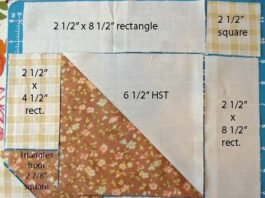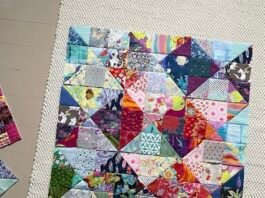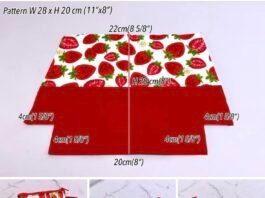Quilting is an art form that combines creativity, precision, and skill. One of the most popular and visually striking designs in modern quilting is the Twisted Quilt Block. This pattern creates a dynamic, spinning effect that can add depth and motion to your quilt. Whether you’re making a throw, a wall hanging, or a full-sized bed quilt, the Twisted Quilt Block – TUTORIAL will guide you through the process of creating these eye-catching blocks step by step.
The Twisted Quilt Block is a great project for quilters who want to explore different fabric combinations and enjoy the challenge of working with angular pieces. The pattern relies on creating precise piecing and sharp angles to achieve the twisted effect. It’s not only visually stunning but also versatile, as you can use various color schemes to personalize it. Whether you prefer bold, contrasting colors or more muted tones, the Twisted Quilt Block adapts well to your style.
In this tutorial, we’ll cover everything you need to know about the Twisted Quilt Block, from fabric selection and cutting to piecing and assembly. So, gather your materials, and let’s get started on creating your own twisted masterpiece!

1. Materials Needed for the Twisted Quilt Block
Before you dive into the Twisted Quilt Block – TUTORIAL, you’ll need to gather all the necessary materials. Here’s a list of what you’ll need to get started:
SEE OTHER FACE PATTERNS HERE!
- Fabric: Choose a variety of fabrics in your preferred color palette. You’ll need several fabrics in contrasting colors to create the twist effect. For each block, you will need light and dark fabrics, as well as any accent fabrics you want to include. Typically, you’ll need around 6-8 fabric pieces for each block.
- Quilt Backing: For the backing fabric, choose a solid or patterned fabric that complements the design. You’ll need enough fabric to cover the entire quilt once completed.
- Quilt Batting: Choose batting based on your preferred quilt thickness and softness. Cotton batting is a common choice, but polyester or blends are also popular.
- Sewing Machine: A sewing machine with a quarter-inch foot is recommended to ensure accurate seams.
- Thread: Use high-quality cotton thread in a neutral color that blends well with your fabric choices.
- Rotary Cutter and Mat: These are essential for cutting your fabric into precise pieces. A rotary cutter ensures straight edges, which is crucial for creating the sharp angles in the twisted block.
- Quilting Ruler: A clear ruler will help you make accurate cuts for your fabric strips and blocks.
- Iron and Ironing Board: Press your seams open as you go to ensure the blocks lie flat and are evenly aligned.
- Pins: These will help hold the fabric pieces in place while you sew.
Once you have everything ready, you can begin the exciting process of creating your twisted quilt blocks!
2. Cutting the Fabric for the Twisted Quilt Block
The first step in making the Twisted Quilt Block is cutting the fabric pieces. Precision is key, so it’s important to measure carefully and cut accurately. Here’s how you can start:
Step 1: Select Your Fabrics
Start by selecting a few fabric patterns and colors that you want to use for your block. You can choose complementary colors for a harmonious look or opt for contrasting colors to make the twisted effect more dramatic. Typically, you’ll use light fabrics for one part of the block and dark fabrics for the other part to create the twisted illusion.
Step 2: Cut the Fabric Strips
To make the block, you’ll need to cut your fabric into strips. Cut your fabrics into strips of various widths, typically between 1.5 and 3 inches wide, depending on the block size you want to create. The strips will form the parts of the block that give it the twisted appearance.
Step 3: Cut the Block Pieces
Once your strips are cut, you’ll need to cut additional fabric pieces for the block’s center and outer parts. For example, you might cut a square for the center of the block and additional strips for the surrounding sections. The size of these pieces will depend on the size of the quilt block you are creating. Make sure to cut everything precisely according to your pattern’s instructions.
3. Piecing the Twisted Quilt Block
The magic of the Twisted Quilt Block happens when you begin piecing the fabric together. The twisting effect is created by strategically sewing fabric strips in a way that appears to twist when the blocks are assembled. Here’s how to piece the block:
Step 1: Sew the Fabric Strips Together
Start by taking two strips of fabric and placing them right sides together. Sew them along the edges with a quarter-inch seam allowance. Press the seams open or to one side after sewing. Continue this process, adding more strips as necessary to form your larger pieced section.
For example, if you are creating a block with four strips, you will sew two strips together, then add the third strip, and finally the fourth. Always press the seams after each addition to keep the block flat and even.
Step 2: Create the Twisted Design
Once you have your strip sections sewn together, it’s time to arrange them to create the twisting illusion. The key to the twisted design is rotating each section of fabric so that the angles form a pattern that appears to spiral outward from the center. You can rotate each strip section by 45 or 90 degrees, depending on the look you want to achieve.
Step 3: Assemble the Block
Once the twisted sections are arranged, sew them together to complete the block. It’s important to ensure that all seams align neatly, as this will help maintain the sharpness of the twisting effect. Press the seams open to keep the block flat.
After assembling the twisted sections, you should have a completed block that has a visually dynamic, swirling effect.
4. Assembling the Quilt Top
Now that you’ve made multiple Twisted Quilt Blocks, it’s time to assemble the quilt top. The beauty of this block is that you can create a wide variety of designs depending on how you arrange the blocks. Here’s how you can assemble your quilt:
Step 1: Layout the Blocks
Start by laying out your completed blocks on a large surface like a design wall or bed. You can arrange the blocks in rows and columns or choose a more random arrangement. Play around with the layout until you find a design that you love. The twisting effect will come to life when the blocks are arranged correctly, so be sure to take your time to get the look just right.
Step 2: Sew the Blocks Together
Once you’re happy with the layout, begin sewing the blocks together. Use a quarter-inch seam allowance for joining the blocks. It’s helpful to pin the blocks together at the seams to ensure they line up correctly. After joining the blocks in rows, sew the rows together to form the entire quilt top.
Step 3: Add Borders (Optional)
If you want to add a border to your quilt, cut fabric strips of the desired width and sew them around the edges of the quilt top. Borders can help frame the quilt design and give it a polished finish.
FAQ – Frequently Asked Questions
1. How can I make my Twisted Quilt Block more dramatic?
To make your Twisted Quilt Block stand out, use contrasting fabrics, such as light and dark fabrics. This contrast will make the twist effect more pronounced and visually striking.
🌟Join our exclusive Quilt broadcast list on Messenger! Receive the best patterns, tips, and updates directly in your inbox. Our team is ready to send you delightful content that will inspire your projects. Don’t miss this opportunity to stay updated and create amazing pieces. Join now and be part of this passionate quilt community!✨📩
2. Can I use this pattern for smaller projects, like table runners or pillows?
Yes, absolutely! You can adjust the block size and number of blocks to create smaller projects like table runners, pillow covers, or even wall hangings.
3. What’s the best way to press seams when piecing the block?
Pressing the seams as you go is essential for keeping your block flat and neat. For this pattern, it’s typically best to press the seams open to avoid bulky intersections. Alternatively, you can press them to one side if you prefer.
4. Can I use precut fabric for this pattern?
Yes, precut fabric strips, such as jelly rolls, are a great option for this pattern. They can save you time on cutting, and the consistent width of the strips ensures uniformity in your blocks.
5. What size should I make my quilt blocks?
The size of your quilt blocks is entirely up to you, but common sizes for twisted quilt blocks range from 8 inches to 12 inches. Adjust the size depending on your overall quilt design.
6. How do I finish the quilt once all the blocks are assembled?
Once your quilt top is finished, you can quilt it using your preferred quilting method (hand or machine quilting). After quilting, bind the edges of the quilt with fabric strips to give it a clean, finished look.
The Twisted Quilt Block is a fun and creative way to add dynamic motion and energy to your quilt. By following this tutorial, you can create beautiful twisted designs that add depth and visual interest to your projects. Whether you’re making a large quilt or a smaller project, this block is adaptable to a variety of sizes and styles.
We hope you’ve enjoyed learning how to make the Twisted Quilt Block! If you have any questions, feedback, or suggestions for future tutorials, feel free to share. Happy quilting!




